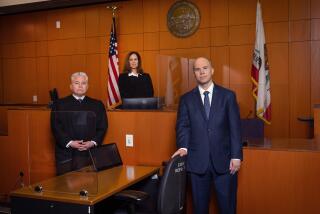Courting a Career, Word for Word : Technology: Advances in use of video and voice-activated computers for legal proceedings have not kept students from enrolling in a stenography school in Westminster.
- Share via
Kathy Hettick has been a manager at McDonald’s. She’s been a data entry operator in Bakersfield. She’s done customer service for a furniture rental store.
Five years ago, Hettick, 38, decided she wanted to learn a marketable skill that would launch her into a well-paying career. So in August 1988 she enrolled in the South Coast College of Court Reporting in Westminster.
“There is always a demand for good court reporters,” Hettick says.
Not in some court systems across the country, including seven Orange County courts where high-tech video equipment has replaced court stenographers. Nor are court reporters in high demand in Kentucky, where most court stenographers have been replaced by the state-of-the-art technology that uses video cameras and voice-activated recorders.
Despite the technological advancements that threaten to make the court reporter a courtroom dinosaur, the number of people entering the field has more than tripled in 20 years. (In 1973 there were 2,550 licensed reporters in the state; in 1983 there were 4,304, and in 1993 there are, so far, 9,200 reporters, according to the Certified Shorthand Reporters Board).
“Court reporter” was even listed recently as one of the “100 best jobs for the 1990s” in a book by Chicago Tribune columnist Carol Keiman, and the author calls the field one of the fastest-growing segments of the service-providing sector.
Most judges and stenographers say that court reporters will, for a long time to come, be an indispensable part of the legal process, even if used only to transcribe tapes. Stenographers are also beginning to incorporate some of the new technology into their reporting techniques.
“The technology which court reporters use runs circles around other technology,” says Rick Black, executive officer of the Certified Shorthand Reporters Board. “Only court reporting technology can go immediately from the spoken word to the written word; audio and video can’t.”
Although Orange County court officials who use videos agree that court reporters are still a necessary part of the process in many ways, they also say that in some circumstances videos work better than stenographers.
“In certain departments which don’t have a need for a reporter except three or four hours a week, video is adequate,” says Orange County Superior Court Presiding Judge Donald E. Smallwood, who uses only video in his courtroom.
“I’m very happy with it,” says Orange County Superior Court Commissioner Eleanor Palk, who also uses video in her court. “It’s made hearings very flexible. And it’s extremely helpful where you need to view the tape for information--you don’t have to wait for a transcript.”
Palk says she also likes video because the camera can pick up the expressions, long pauses and voice inflections that won’t necessarily show up on the transcript.
“Those who have video equipment like it very much,” she says. “The drawbacks are that when the equipment breaks down there you are, with no reporter. . .”
*
The most recent court recording technology, heralded as the wave of the future, uses both computers and stenographers. In “real-time translation,” the reporter types onto a steno machine hooked up to a computer that instantly translates the notes into words flashed onto a computer screen. The hard copy of the translation can be automatically printed out at the end of the day. (No new skills are needed for reporters to use real-time translation).
Real-time translation also allows attorneys and judges to gain access to previous testimony and legal databases while in court.
Los Angeles Superior Court Judge George Trammell is working with an Irvine-based company called Stenocat to make the technology available to all courts. Trammel’s is the only court in Los Angeles or Orange County that has a complete system, which includes a computer screen in front of the judge, attorneys and court reporters.
“Lawyers and courts are way behind in the rest of the world in the use of computers and what we do in our everyday lives,” Trammell says. “We’re just coming out of the Dark Ages and just getting into the computer age.”
A few other courts in Los Angeles, Long Beach, Pamona and Van Nuys use scaled-down versions of real-time computers, which link only the judge and court reporter. Trammel says the complete system, linking judge, court reporters and attorneys, would cost about $20,000 per court; video systems cost about $60,000.
*
The world of “certified shorthand reporters,” popularly known as court reporters, is one of 60-hour weeks and high stress that some insurers consider second only to that of air traffic controllers. For hours a day they sit stoically striking a silent keyboard recording the minute goings on of court proceedings, and for hours more they translate odd-looking symbols into printed transcripts.
Despite the stress and monotony, those who enter the field say it provides flexibility, excitement and a good salary.
“It gives you choices,” says Julie Jones, 24, a court reporting student at South Coast College whose sister is a court reporter. “It’s good for people who have families--you can work two days a week and make a decent amount of money.”
Part-time court reporters can make about $35,000 a year, while full-time reporters can earn more than $100,000.
In addition to reporting court proceedings and depositions, court reporters often pursue alternative careers including closed-captioning for television stations, entering data into computers for large corporations and helping deaf students participate in classes alongside hearing students.
Unlike most government employees, court reporters are salaried and at the same time independent contractors--which allows them to work free-lance in addition to their salaried jobs to substantially increase their income.
Dean Larson, 30, was considering law school before he chose to become a court reporter.
“There is such a glut of lawyers, I was forced to turn to different options,” says Larson, 30, who transferred to South Coast College from a court reporting school in Denver last year. “With court reporting, I can stay close to the legal profession and still make the amount of money I was interested in.”
*
Becoming a court reporter is not easy. At South Coast College, training usually involves four years of full-time study or six years of night school, though some students spend up to nine years juggling other work before they are able to pass the grueling two-day state licensing exam.
The exam, held twice a year, tests knowledge of vocabulary, medical and court terms. Students must also be able to type 200 words per minute with 97.5% accuracy. Only 40% of those who take the test in the state pass.
“It looked really challenging and is so different from any other profession--there’s a lot more learning,” says Michelle Gracie, 29, a Whittier resident who has worked full time while attending the school for nine years.
Student Maria Christensen, 23, came across an ad for South Coast College last year when she was looking through the Penny Saver for a wedding gown. After speaking with counselors at the college and brushing up on her typing speed, she signed up.
“It’s the best thing that ever happened to me,” she says.
More to Read
Inside the business of entertainment
The Wide Shot brings you news, analysis and insights on everything from streaming wars to production — and what it all means for the future.
You may occasionally receive promotional content from the Los Angeles Times.









